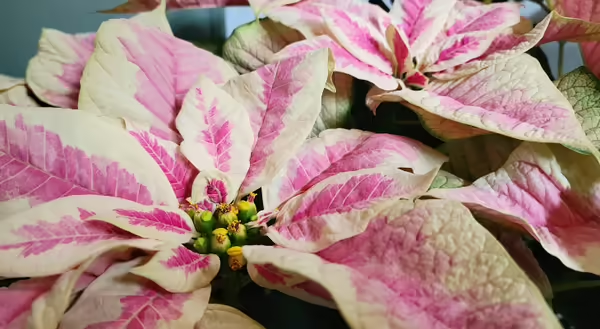
The festive poinsettia, Euphorbia pulcherrima, is a lovely addition to holiday décor. The bright, cheery plant, a native to Mexico, comes in many colors and sizes making it a good choice to brighten up the long, dark days of winter.
The showy colored parts of the poinsettia are colored bracts. The yellow flowers or cyathia are in the center of the bracts.
For the longest display of color, selecting healthy plants is key. Look for a plant that has dark green foliage down to the soil line. Notice the bracts, they should be completely colored. Check for the presence of pollen on the small flowers in the center of the bracts. These small, central flowers should be red-tipped or green with little or no pollen.
Select a plant that is attractive from all sides. It should be full and balanced with a height 2 ½ times the diameter of the container for the best display.
With poinsettias, the best way to manage pests is prevention. Check for signs of pest such as white flies and aphids when choosing which plant to bring home. Choose a plant that has no signs of pests.
A plant that is in wet soil but is wilted is showing signs of rot root.
It is important to know what to look for in selecting a poinsettia but knowing what to avoid is also helpful.
Avoid plants that are drooping or wilting. A plant that is stressed is likely to drop the bracts sooner meaning a shorter time it can be displayed.
Check the soil. A plant that has wilted leaves in wet soil is showing symptoms of root rot.
Avoid plants that are displayed in plastic or paper sleeves. These plants might be weakened and not adjust well to being displayed. Also avoid are plants that are too crowded together.
If the cyathia are covered in pollen, that is a sign that the flowers are very mature. Since the bracts drop soon after the pollen is released, the display time for these plants will be shortened.
Healthy plants that are properly cared for can last for 6 to 8 weeks in the home. Keeping these things in mind as you choose you plants will allow the beautiful poinsettia throughout the holiday season.
MEET THE AUTHOR
Nicole Flowers-Kimmerle is a Agriculture and Natural Resources (Horticulture) Educator for Fulton, Mason, Peoria and Tazewell counties. She completed a bachelors of science degree in crop science at the University of Illinois, and a master’s of science degree in agronomy with an emphasis in weed science at the University of Wisconsin-Madison. She has also worked at Montana State University as a research associate where she worked on weed control in sugar beets and barley. She taught high school chemistry and other science classes where she was able to teach students in both the school garden and greenhouse. She works with both the Extension Master Gardeners and Extension Master Naturalists.
ABOUT THE BLOG
ILRiverHort is a blog that helps people connect to nature and grow.